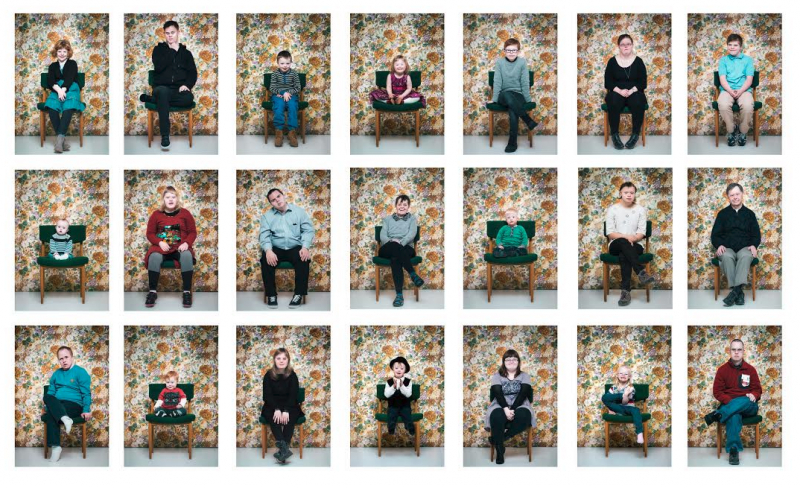Photo book - Portraits of people who have Down’s Syndrome - The ethical questions of man's authority to decide who gets to live and who doesn't are the issues addressed in Sigga Ella's series of photographs
To add milestones and tasks to your plan, please send them via e-mail to info@karolinafund.com. Tell us which tasks you have already finished (checked) and which ones are left.
Showing what the plan is for your project helps build trust with potential backers.
The world with or without Downs:
The ethical questions of man's authority to decide who gets to live and who doesn't are the issues addressed in Sigga Ella's series of photographs which she names "First and foremost I am". The series consists of 21 portraits of people who all have Down’s Syndrome and the reason for that number is because the trisomy of the 21st chromosome causes Down’s Syndrome. She chose to photograph people of all ages and both genders and wanted to show that each of these individuals is a person like anyone else and should not be judged by one extra chromosome.
Sigga Ella says that the idea for the project came to her when listening to a radio program where these issues were discussed. „The reason I did this project was because of this radio interview I heard, where they were discussing the ethical questions we now face, that we can choose who gets to live and who doesn't, as the aim of prenatal diagnosis is to detect birth defects such as Down’s Syndrome and more. Where are we headed? Will people choose not to keep an embryo if they know it has Down’s Syndrome? I had a lovely aunt with Down’s Syndrome, aunt Begga. It is very difficult for me to think about the elimination of Down’s Syndrome and her at the same time.“
Sigga Ella portrays these 21 individuals in the same setting; sitting in the same chair, facing the camera, with the backdrop of a colorful flower wallpaper. The lighting is plain and simple and serves this purpose well. Sigga Ella carefully controls the setting, keeping in mind, not to draw attention to anything but the subject itself. By doing so, each individual stands out and there is nothing that distracts the viewer from the person. The colorful and happy backdrop relates to the diversity and colorfulness of the human race. It shows us that all kinds of flowers can grow and flourish together, and we should also cherish the diversity of humans. Although Sigga Ella controls the setting, she does not control the people but rather lets them show us who they are. Each photograph shows us a person with his or her own special characteristics. Some are smiling, others giggling and hands and feet are placed freely. Within the setting Sigga Ella obviously gives them full freedom which brings out their uniqueness as individual human beings. The clothes they are wearing are all different as well and that too accentuates the fact that these people are by no means all alike, although they share the same syndrome."First and foremost I am" is an eyeopener for the beauty and diversity of mankind and makes us wonder if the future without this diversity is desirable.
Ásdís Ásgeirsdóttir, photographer and B.A. in Art Theory and M.A. in Journalism.
---------------------------------------
"With a plain, green chair against a floral backdrop, an Icelandic artist is showing the diversity and beauty of humankind."
THE HUFFINGTON POST
"Stunning portraits."
CNN
"Icelandic photographer Sigga Ella has created a simply gorgeous series of portraits of people with Down’s Syndrome."
THE METRO

--------------------------------------------
Garðar 9 years old
I am Garðar
I am a son
I am a brother
I am wonderful
I am stubborn
I am kind
I am helpful
I am determined
I like the theatre
I love dogs
I am a great impersonator
I like to tease
I am a music lover
Garðar is an indispensable character on the stage of life

-------------------------------------
The inspiration behind the project came from a radio interview Sigga Ella heard on prenatal diagnosis – a common procedure which tests for specific conditions in embryos during pregnancy, including Down’s syndrome: “I am fascinated by the ethical questions. Who gets to decide who lives or dies? We need to ask ourselves where technology is taking us. In today’s world, many people decide not to go through with pregnancies if the syndrome is detected. What’s next? Where will we draw the line? It’s important that we increase education about the syndrome and what it actually entails – it is not a disease. The topic is common to all of us, no matter where we are in the world. It’s a discussion that is needed everywhere.
The project has already garnered widespread attention and has been featured in international media such as CNN, The Metro and The Huffingtonpost."
--------------------------------------
The book will be in two languages: Icelandic and english

--------------------------------------------
Sigga Ella, born in Akureyri, Iceland, graduated from The School of Photography in Reykjavík and is currently living in the capital. Her main interests are photographing people. She has taken part in two of Mary Ellen Mark´s workshops, first in 2012 as an intern and in 2014 when she received a grant from IFTA to attend the workshop as a student.
Karolina Fund ehf © 2025 | Kt: 460712-1570 | VAT: 111464 | Bjargargata 1, 102 Reykjavík, Iceland